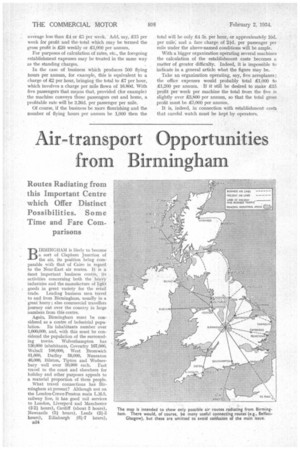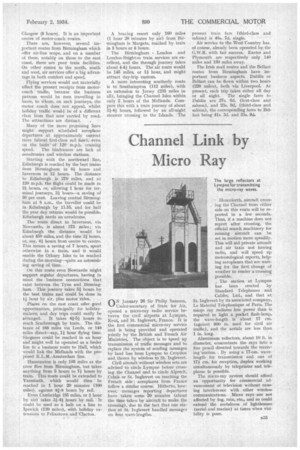Air-transport Opportunities from II irmingham
Page 48

Page 49

If you've noticed an error in this article please click here to report it so we can fix it.
Routes Radiating from this Important Centre winch Offer Distinct Possibilities. Some Time and Fare Com parisons
IRMINCHAM is likely to -become • a sort of Clapham Junction of the air, its position being comparable with that of Cairo in regard to the Near-East air routes. It is a Most important business centre, its activities concerning both the .heavy industries and the manufacture of light goods in great variety for the retail
trade. Leading business men travel to and from Birmingham, usually in a great hurry ; also commercial travellers journey out over the country in large numbers from this centre.
Again, Birmingham must be considered as a centre of industrial population. Its inhabitants number over 1,000,000, and, with this must be considered the population of the surrounding towns. Wolverhampton has 130,000 inhabitants, Coventry 167,000, Walsall 100,000, West Bromwich 81,000, Dudley 59,000, Nuneaton 46,000, Bilston, Tipton and Wednesbury well over 30,000 each. Fast travel to the coast and elsewhere for holiday and other purposes appeals to a material proportion of these people.
What travel connections baS Birmingham at present? Although not on the London-Crewe-Preston main L.M.S. railway line, it has good rail services to London, Liverpool and Manchester (2.24 hours), Cardiff (about 3 hours), Newcastle (51 hours), Leeds (21-3 hours), Edinburgh (fli-1 hours),
n34 Glasgow (8 hours). It is an important centre of motor-coach routes.
There are, however, several important routes from Birmingham which offer air-line scope, and on a number of these, notably on those to the east coast, there are poor train facilities. On other routes to the north, south and west, air services offer a big advantage in both comfort and speed.
Flying services would not materially affect the present receipts from motor coach traffic, because the business patrons would be men travelling in haste, to Whom, on such journeys, the motor coach does not appeal, whilst holiday traffic would be of a different class from that now carried by road.
The attractions are distinct. .
Many of the more promising lines might support scheduled aeroplane departures at approximately current rates (about first-class rail fare), even on the basis of 120 m.p.h. cruising speed. The hindrances are lack of aerodromes and wireless stations.
Starting with the northward line. Edinburgh is reached by the best trains from Birmingham in 04 hours and Inverness in 12 hours. The distance to Edinburgh is 270 miles, and at 120 m.p.h. the flight could be made in 21 hours, or, allowing 1 hour for terminal journeys, 31 hours—a saving of 50 per cent. Leaving central 13irmingham at 8 a.m., the traveller could be in Edinburgh by 11.15, and for half the year day returns would be possible. Edinburgh needs an aerodrome.
The route direct to Inverness, via Newcastle, is about 375 miles ; via Edinburgh the distance would be about 450 miles, and the time 31 hours, or, say, 41 hours from centre to centre.
This means a saving of 7 hours, spent otherwise in a train, and it would enable the Orkney Isles to be reached during the morning—quite an astonishing saving of time.
On this route even Newcastle might support regular departures, having in mind the business connections that exist between the Tyne and Birmingham. This journey takes 51 hours by the hest trains and could be done in 1i hour by air, plus motor rides.
Places on the east coast offer good opportunities, principally for holiday makers, and day trips could easily be arranged. It takes 41-5i hours to reach Scarborough by train. The dis tance of 160 miles via Leeds, or 140 miles direct—say, 11 hour flying time. Skegness could be reached in an hour and might well be operated as a feeder line to a business route to Hull, which would link the Midlands with the proposed K.L.M.-Amsterdam line.
Hunstanton is only 105 miles as the crow flies from Birmingham, but takes anything from 5 hours to 7i hours by train. This route could be extended to Yarmouth, which would then • be reached in 1 hour 20 minutes (160 miles), against 61-9 hours by rail.
Even Cambridge (85 miles, or hour by air) takes 31-4i hours by rail. It could be used as a halt on a line to Ipswich (130 miles), with holiday extensions to Felixstowe and Clacton. A bracing resort only 160 miles (1 hour 20 minutes by air) from Birmingham is Margate, reached by train in 5 hours or 6 hours.
The Birmingham London and London-Brighton train services are excellent, and the through journey takes about 4-0 hours. The air route would be 145 miles, or 11 hour, and might attract day-trip custom.
A more interesting southerly route is to Southampton (112 miles), with an extension to Jersey (235 miles in all), bringing the Channel Isles within only 2 hours of the Midlands. Compare this with a train journey of about 3/-4i hours, followed by an all-night steamer crossing to the Islands. The present train fare (third-class and saloon) is 48s. 7d. single. • Air service to the West Country has, of course, already been operated by. the G.W.R. with fair success. Exeter and Plymouth are respectively only 140 miles and 180 miles away.
The Irish mail routes and the Belfast routes from Birmingham have important business aspects. Dublin or Belfast can be flown within two hours (220 miles), both via Liverpool. At present, each trip takes either all day or all night. The single fares to Dublin are 37s. 6d. (first-class and saloon),• and 23s. 9d. (third-class and saloon), the corresponding fares to Belfast being 41s. 3d. and 33s. 94




























































































